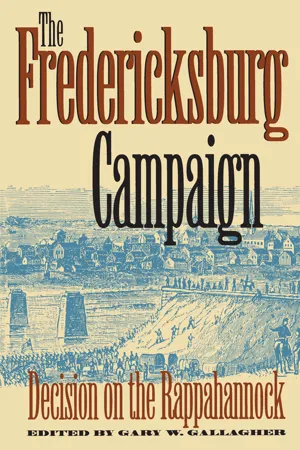History
Battle of Fredericksburg
The Battle of Fredericksburg was a major engagement during the American Civil War, fought in December 1862 in Virginia. It was a significant Confederate victory, with General Robert E. Lee's forces successfully repelling repeated Union assaults. The battle resulted in heavy casualties for the Union army and is remembered for the formidable defensive position held by the Confederates.
Written by Perlego with AI-assistance
Related key terms
2 Key excerpts on "Battle of Fredericksburg"
- eBook - ePub
- William C. Davis, Brian Pohanka, Don Troiani(Authors)
- 1997(Publication Date)
- Thomas Nelson(Publisher)
FREDERICKSBURGTheSECOND YEAR OF THE CIVIL WAR had taken a great toll on the armies of both the North and the South. Union Maj. Gen. George B. McClellan had spent all spring slogging through the swamps of Virginia’s peninsula only to be repulsed and retreat shortly after his army caught sight of the church spires of Richmond. By late summer, Gen. Robert E. Lee, the new commander of the main Confederate army, the Army of Northern Vir–ginia, had routed another Union army under Maj. Gen. John Pope at the battle of Second Manassas, twenty-five miles south of Washington, D.C. Then came the battle of Antietam in mid-September, when Lee was forced to abort his first invasion of the North by an army com–manded again by McClellan. In the early winter months of 1862, the Union seemed poised for victory.The Federal forces were rested and reequipped. They were ready to launch a second drive to Richmond. At the halfway point between Washington and Richmond was the colonial-era town of Fredericksburg, Virginia. At first glance on a map, the town appears to be just a stop on the road to Richmond, but it was to become the next great proving ground for the superiority of the Union army. A series of blunders and delays here left the Federal soldiers devastated and demoralized. At Fredericksburg the Rebel forces found new hope, and at Fredericksburg the Union soldier began to doubt the ability of his mili–tary commanders, his political leaders, and his moral cause to restore the Union.This was evidenced in the soldiers’ letters home. For example, Henry Hastings Curran of the 146th New York wrote: “Dear Mother, the fearful Battle of Fredericksburg is over. The slaughter is terrible. The result is disastrous. Until we have good generals, it is useless to fight battles. Our real loss is far greater than reported in the newspapers.” There is little doubt that Curran’s feelings reflected those of the entire Union army.WCDWilliam C. Davis GWGGary W. Gallagher AWGa. Wilson Greene - eBook - ePub
The Fredericksburg Campaign
Decision on the Rappahannock
- Gary W. Gallagher(Author)
- 2000(Publication Date)
- The University of North Carolina Press(Publisher)
Barbarians at Fredericksburg’s Gate
THE IMPACT OF THE UNION ARMY ON CIVILIANS WILLIAM A. BLAIRFredericksburg residents quickly grasped the significance of the two cannon shots that cracked across the cold, crisp dawn of December 11, 1862. Southern artillerists fired the guns to alert the Army of Northern Virginia to prepare against attack and to let civilians know that the moment so long dreaded finally had come. Townspeople had spent a sleepless night fretting over what to pack, justifiably worried about what would happen to property left behind. As the echo of the shots died, people carrying bedding and household goods filled roads leading to woods behind the Confederate army. Shortly after noon, after a morning of sporadic artillery firing, more than 140 Union guns opened on the town, creating a smoke screen through which bursting shells winked like “a countless swarm of fire-flies.” The destruction outraged a populace still naively believing that civilians and their property should remain exempt from carnage. The next day Federal soldiers added a more personal stamp to the violation by breaking into homes and public buildings, rifling belongings, parading in dresses stripped from wardrobes, and smashing furniture during an orgy of looting that only seemed to confirm the stereotype of the barbaric Yankee.1The sacking of Fredericksburg scarred the town and its inhabitants. For months awestruck visitors remarked about the devastation. Surviving photographs show skeletons of buildings standing amidst rubble—scenes suggestive of European cities bombed during World War II. This visit from the Federal army was neither the first nor the last. Standard accounts of the war ignore an earlier Federal occupation from late April to August 1862, during which the mayor and eighteen other community leaders had been held as political hostages. The townspeople experienced a war more complicated than the familiar description of a conflict moving in discrete stages from limited to total, with strategic targets gradually expanding from armies to civilians. On the Confederacy’s frontier a hard war occurred as soon as Union troops encountered Confederate loyalists, with depredations escalating after Maj. Gen. George B. McClellan’s failure on the Peninsula. In their wake the invaders left destruction in northern Virginia as extensive as in the more celebrated areas of the Deep South touched by Sherman’s army.2
Learn about this page
Index pages curate the most relevant extracts from our library of academic textbooks. They’ve been created using an in-house natural language model (NLM), each adding context and meaning to key research topics.

